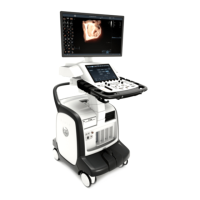General Procedures and Functional Checks
4-16 Vivid E80/E90/E95 – Service Manual
GC091052
Rev. 3
3. Press Trackball to allow free rotation of the solid full-length
cursor line throughout the 2D image (trackball assigned
function: Angle).
4. Rotate the solid cursor line to the desired direction.
Curved Anatomical M-Mode
1. In M-Mode, press Curved AMM.
2. Use the trackball (assigned function: Pos) to position the
starting point of the time motion curve.
3. Press Select to anchor the starting point of the time motion
curve.
4. Use the trackball to position the next point of the time motion
curve.
5. Press Select to anchor the point of the time motion curve.
6. Repeat step 4 and 5 up to draw a complete time motion
curve.
NOTE: The time motion curve can be edited by following the curve
back to the desired point and redraw.
7. On the last point, press Select twice to terminate the curve.
NOTE: To edit the time motion curve, select a point, move it to a
new position and press Select.
Optimizing M-Mode
The use of preset gives optimum performance with minimum
adjustment. If necessary, the following controls can be adjusted
to further optimize the M-Mode display:
NOTE: Refer to ‘Creating presets’ on page 4-8 about creating presets.
• Adjust Horizontal sweep to optimize the display resolution.
• Adjust Gain and TGC controls to adjust the range to be
imaged.
• Use the Frequency (move to higher frequencies) or the
Frame rate control (move to lower frame rate) to increase
resolution in image.
• Adjust Dynamic range to optimize the useful range of
incoming echoes to the available grayscale.
• Adjust Compress to further optimize the display.
• Adjust Reject to reduce noise while taking care not to
eliminate significant low-level diagnostic information.

